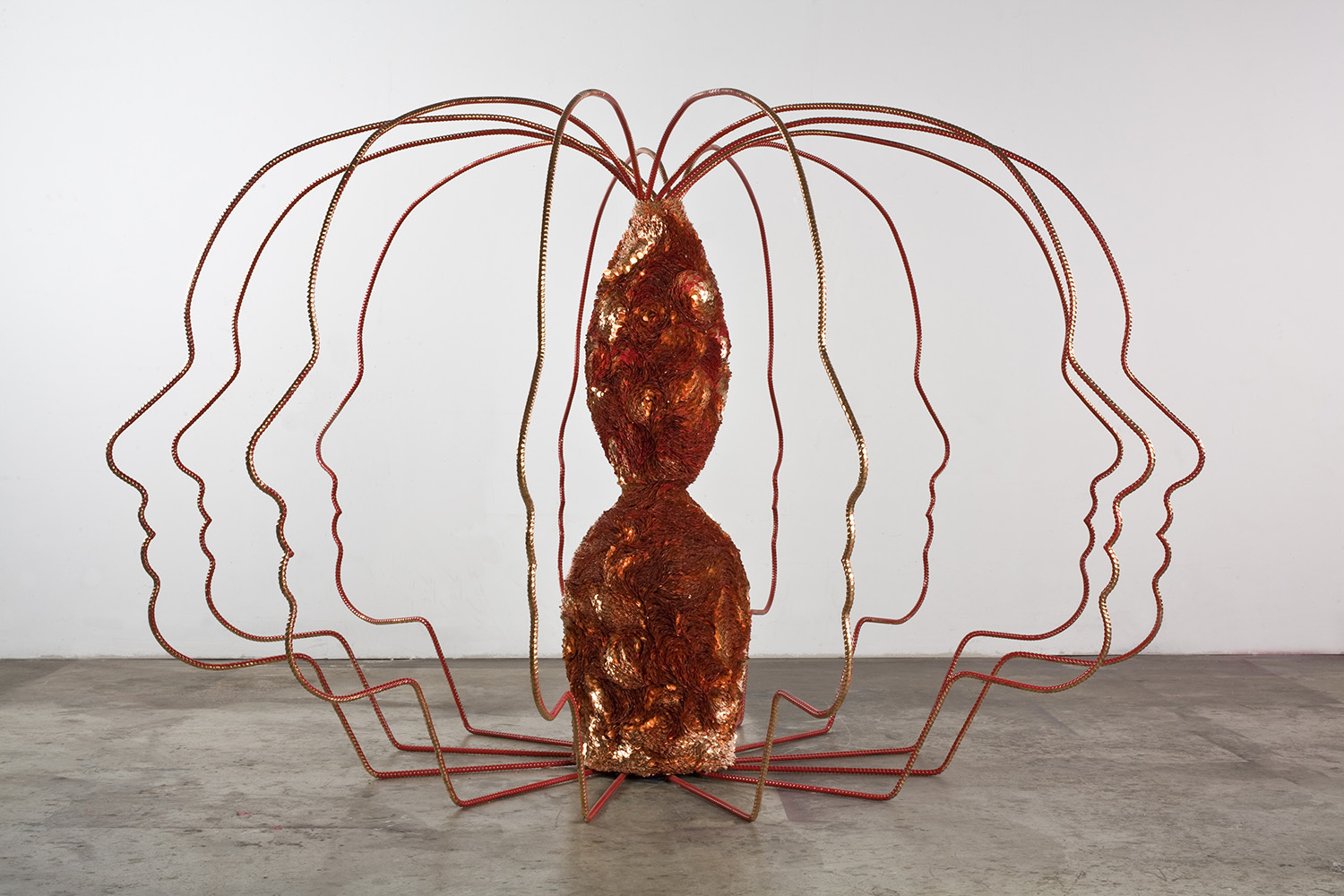


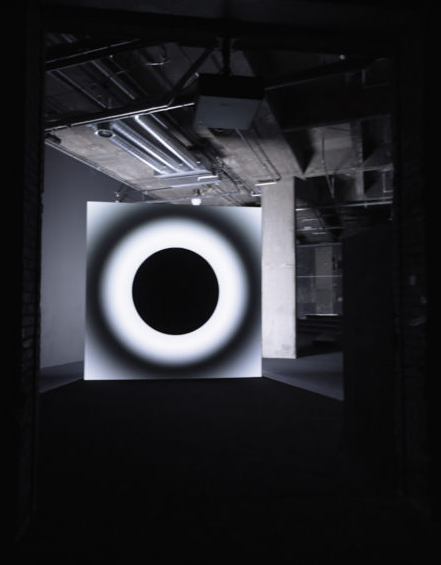
Ryoji Ikeda
point of no return
With point of no return, Ryoji Ikeda condenses the unknowable chaos of the event horizon of a black hole into a work of order and balance. Composing a delicate assemblage of basic shapes, sounds, light and shadow, the artist eschews the intricacies of data for a more sculptural approach. While gesturing towards the sublime, the infinite expanse of space and the immense, reality-warping gravitational force of a black hole, he focuses in on the beauty of the physical, bringing together a few simple elements to make sense of something unthinkably complex. Through his own artistic process of playing with space, the artist finds purity in basic structures while drawing inspiration from the vast scope of the universal. “point of no return is a very simple, very intense piece,” he says.
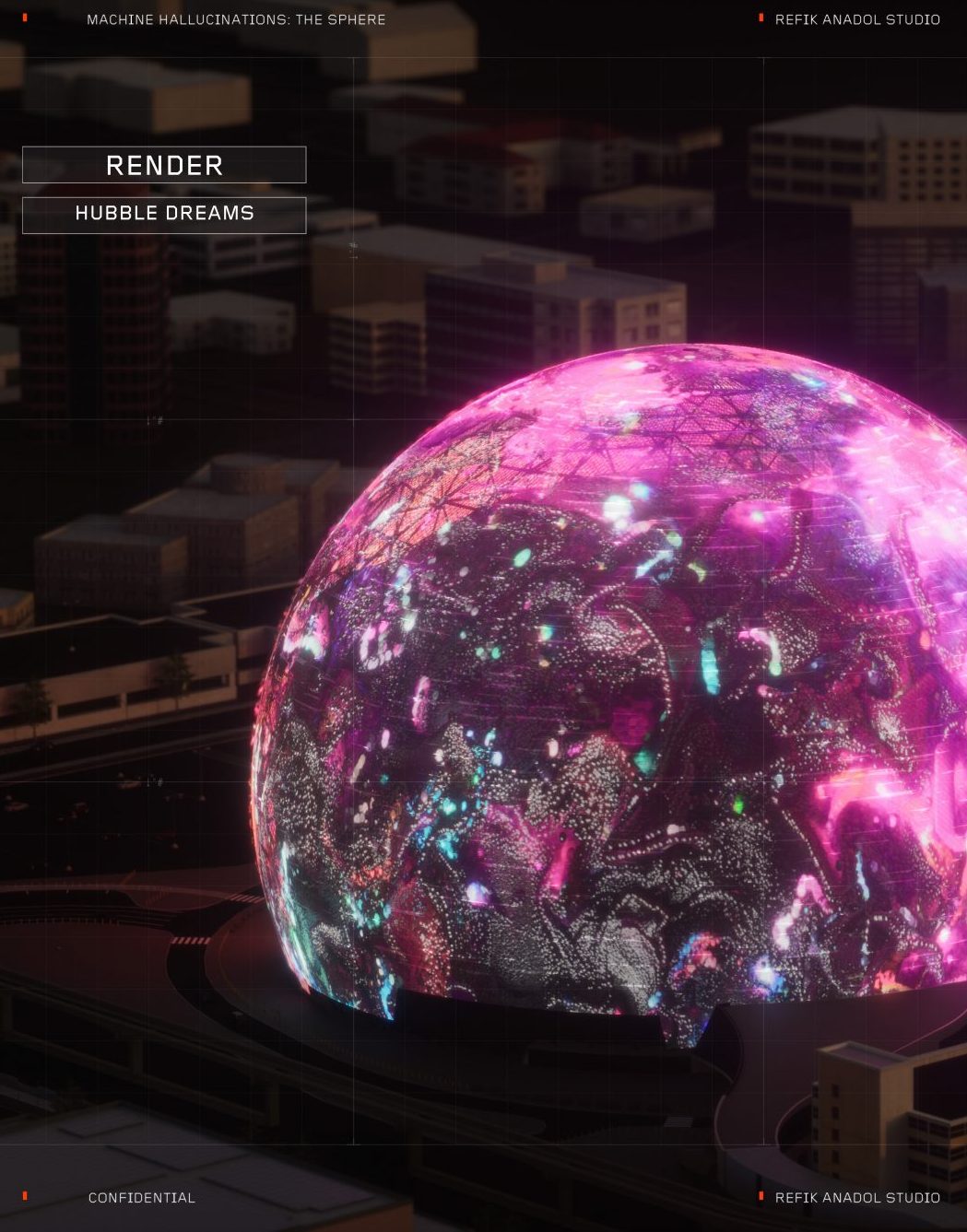
Refik Anadol
Machine Hallucinations — Sphere
The artwork presents a series of AI Data Sculptures that incorporates vivid pigments, shapes, and patterns, aiming to create a collective, meditative, and multisensory experience. This immersive experience simulates the rhythms of various environments and invites the visitors to imagine alternative realities constructed by invisible data movements around them.
Machine Hallucination: The Sphere features dynamic visualizations of data that are based on vast archives containing visual imageries of space and nature while celebrating the unique architecture of The Sphere. For this project, Anadol and his team used these themed datasets as the building blocks for the three distinct chapters of the artwork and trained a unique AI model with subsets of the collected image archives. After the training, when idle and unsupervised, the “machine mind” generates new aesthetic visuals and color combinations through unique lines drawn by algorithmic connections.
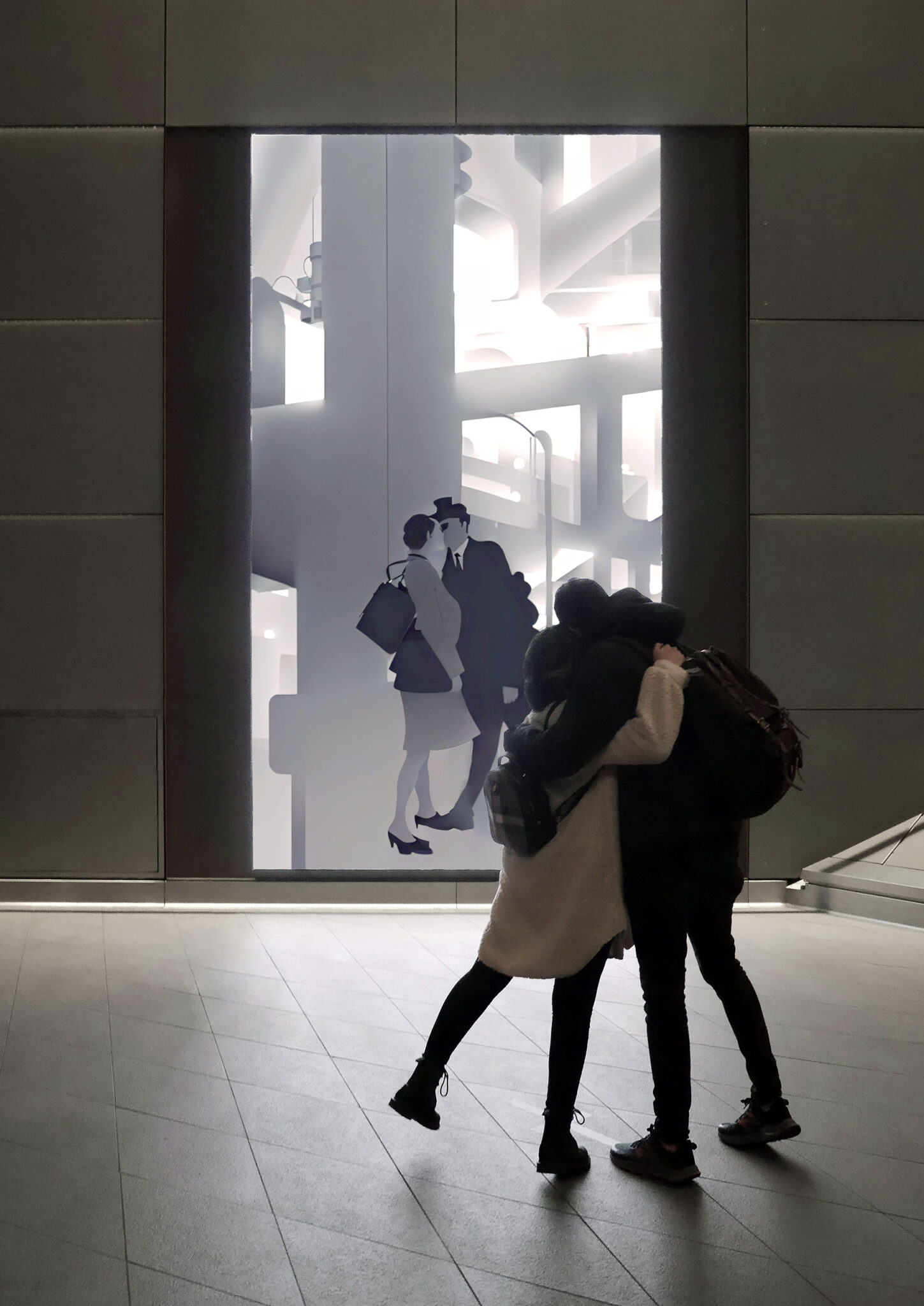
QUBIT AI: Matthias Oostrik
The Forgettable Art Machine
FILE 2024 | Installations
International Electronic Language Festival
The Forgettable Art Machine is an artificial intelligence-driven video installation. When facing the panel, the public has their image captured, starting a cycle of analysis, creation and destruction. From this data, a composite emerges, slowly transforming the visitors’ image into a generative visualization. Once the cycle is complete, the composition is deleted, waiting for a new audience to be captured.
Bio
Matthias Oostrik works at the intersection of digital art, installation art, cinema and architecture. His works establish unpredictable relationships between people and their surroundings. Using digital technology, his installations allow visitors to reshape their environment and their relationships with each other. Oostrik collaborates with renowned professionals and, above all, with his audience, who often become an integral part of his work.
Credits
Co-production: Zester
IA Music: Than van Nispen

QUBIT AI: Lukas Radavicius
Architecture Concepts Created by AI – Can AI Become an Architect?
FILE 2024 | Architectural Synthetics
International Electronic Language Festival
Lukas Radavicius – Architecture Concepts Created by AI: Can AI Become an Architect? – Lithuania
In recent years, artificial intelligence technologies have advanced significantly in the art world, becoming a vital tool for artists in a variety of disciplines, including architecture. Lukas Radavicius has created videos demonstrating the current capabilities of AI in architecture, showcasing innovative designs that offer insights into the potential of AI to shape the future of architecture.
Bio
Lukas Radavicius, born in Kaunas, Lithuania, is a passionate visual artist who began his career in architecture before moving into graphic design and 3D graphics. With a degree in architecture from the Kaunas Academy of Art, he remains active in design-related fields while exploring the fascinating world of AI art in his spare time.

QUBIT AI: Lukas Radavicius
Architecture Concepts Created by AI: Artificial Intelligence Modern Architecture
FILE 2024 | Architectural Synthetics
International Electronic Language Festival
Lukas Radavicius – Architecture Concepts Created by AI: Artificial Intelligence Modern Architecture – Lithuania
In recent years, artificial intelligence technologies have advanced significantly in the art world, becoming a vital tool for artists in a variety of disciplines, including architecture. Lukas Radavicius has created videos demonstrating the current capabilities of AI in architecture, showcasing innovative designs that offer insights into the potential of AI to shape the future of architecture.
Bio
Lukas Radavicius, born in Kaunas, Lithuania, is a passionate visual artist who began his career in architecture before moving into graphic design and 3D graphics. With a degree in architecture from the Kaunas Academy of Art, he remains active in design-related fields while exploring the fascinating world of AI art in his spare time.

QUBIT AI: Lukas Radavicius
Architecture Concepts Created by AI: Architecture Concepts Made by AI
FILE 2024 | Architectural Synthetics
International Electronic Language Festival
Lukas Radavicius – Architecture Concepts Created by AI: Architecture Concepts Made by AI – Lithuania
In recent years, artificial intelligence technologies have advanced significantly in the art world, becoming a vital tool for artists in a variety of disciplines, including architecture. Lukas Radavicius has created videos demonstrating the current capabilities of AI in architecture, showcasing innovative designs that offer insights into the potential of AI to shape the future of architecture.
Bio
Lukas Radavicius, born in Kaunas, Lithuania, is a passionate visual artist who began his career in architecture before moving into graphic design and 3D graphics. With a degree in architecture from the Kaunas Academy of Art, he remains active in design-related fields while exploring the fascinating world of AI art in his spare time.

QUBIT AI: Hassan Ragab
Audio Responsive Treehouse
FILE 2024 | Architectural Synthetics
International Electronic Language Festival
Hassan Ragab – Audio Responsive Treehouse – United States
This work, created using generative artificial intelligence tools, is part of a broader exploration into discovering architectural forms through the intersection of different media. Potential shapes are generated based on the rhythms and timbres of the Shockone vs. Shockone song Run. The Bloody Beetroots. Factors such as camera movement and dynamics between the interior and exterior of the treehouse contribute to the creative process.
Bio
Hassan Ragab is an interdisciplinary media artist, architect and designer whose work focuses on the synergy between art, architecture, technology and humanity. He uses generative artificial intelligence to create a new visual language, and his work is exhibited globally. Additionally, Hassan writes about the integration of new media into art and design and has been recognized in numerous publications and news outlets.
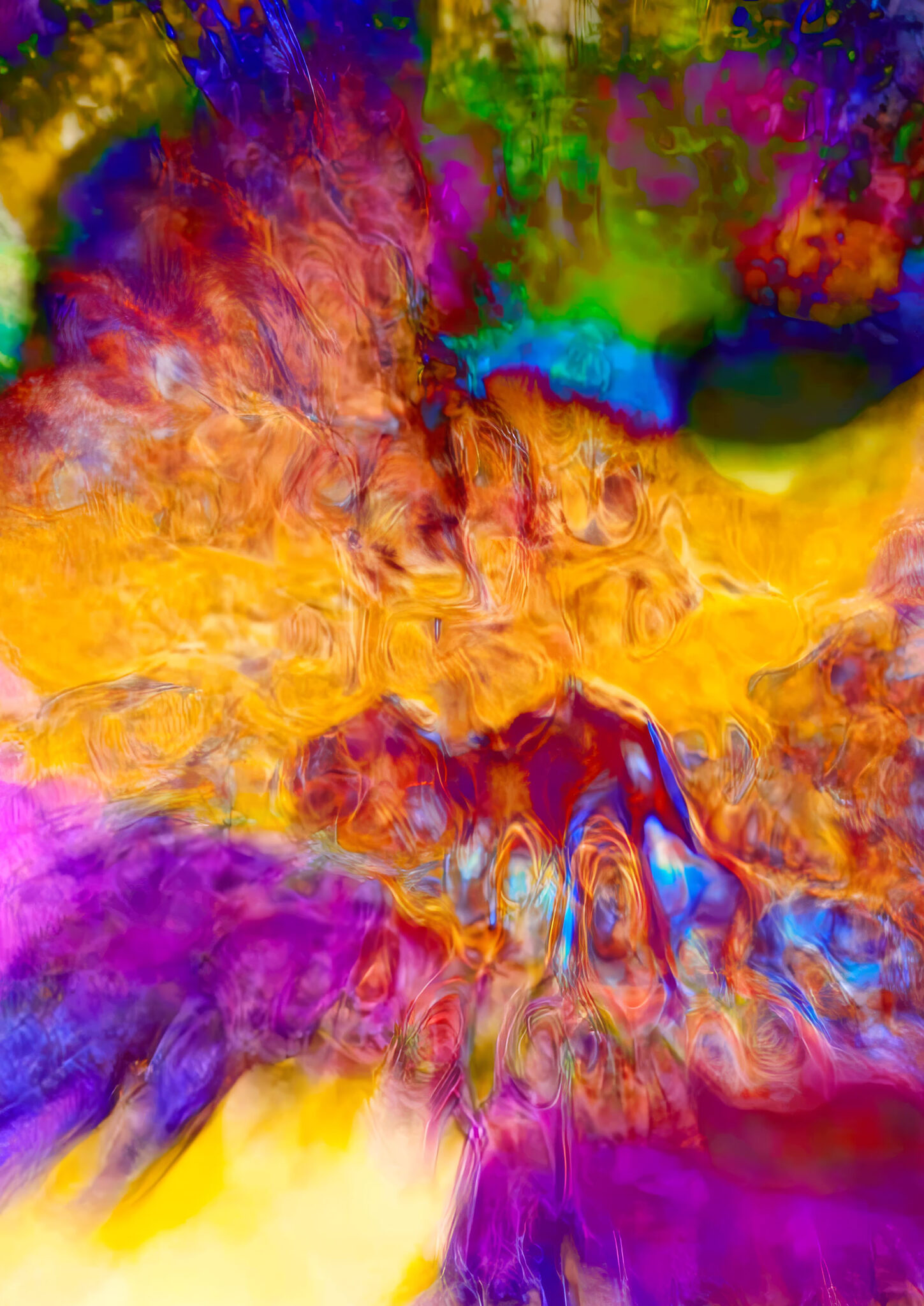
QUBIT AI: Michael Sadowski (aka derealizer)
Stealth Technology of Ancient, Cosmic Pantheons
FILE 2024 | Aesthetic Synthetics
International Electronic Language Festival
Michael Sadowski (aka derealizer) – Stealth Technology of Ancient, Cosmic Pantheons – Austria
An abstract painting in motion, with colors and shapes exploding and transforming to the rhythm of the music. The dynamic element is not trapped in a static image, but can unfold in time and space.
Bio
Using Stable Diffusion, a visual synthesizer, the artist turns fantasies into videos using just a PC, similar to the invention of printing 600 years ago. Exploring the interplay between software algorithms that create visual worlds and the artist’s mind guiding this process is incredibly exciting. Unlike traditional cinema, there is no ‘reality’ or humans involved, making it a satisfying medium for creating visual art.
Credits
Visuals: Michael Sadowski
Music: Stealth Technology of Ancient, Cosmic Pantheons by The Intangible

QUBIT AI: Iskarioto Dystopian AI Films
Athena
FILE 2024 | Interator – Sound Synthetics
International Electronic Language Festival
Iskarioto Dystopian AI Films – Athena – Spain
Athena is a captivating animation that immerses you in a psychedelic and nostalgic journey, evoking the retro aesthetic of 80s anime with its vibrant visual style. A world full of bright colors, geometric shapes and surreal landscapes that explores the corners of the human mind, providing a unique visual experience.
Bio
Iskarioto Dystopian AI Films is an emerging Spanish artist, empowered with cutting-edge AI tools, a fusion of human creativity with machine potential. He is known as a visual alchemist, pixel manipulator, and graphic, dark, dystopian storyteller. Since its premiere in 2022, it has been shown in art galleries around the world, having won the Artistic Award at the AI Film Festival Montpellier 2023.
Credits
Music: Athena by Karl Casey

Olafur Eliasson
DET LYTTENDE SPEJL
Visitors to DNV-Gødstrup, a new hospital near Herning, Denmark, are greeted at the main entrance by an airy, round pavilion. Two curved pipes, crossing one another perpendicularly, hold a large disc aloft at a slight angle. The reflective underside of the disc mirrors the semicircular pipes, creating the illusion of two complete circles passing through the ceiling and rising into an imaginary space above. As visitors enter the pavilion, they can gaze up at their own reflections in the mirror and see themselves incorporated, upside down, into the artwork, embraced within the globe drawn by the pipes. The tilt of the ceiling allows the reflections to be seen from the outside. As the viewer moves towards and around the pavilion, the rings appear to shift in shape, changing from ellipses to circles and back again.

Alexander Ekman and Mikael Karlsson
Eskapist
Palco : Royal Swedish Opera, Stockholm
.
…sem nunca sacrificar a beleza lírica e a contemplação profunda à incongruência inútil, Eskapist prova mais uma vez que o palco teatral é verdadeiramente mágico lugar, onde o mundo como o conhecemos muda de forma apenas para se dissolver nas fantasias mais poéticas que alguém poderia imaginar.
.
Skapist
Stage : Royal Swedish Opera, Stockholm
. …without ever sacrificing lyrical beauty and deep contemplation to pointless incongruity, Eskapist proves once again that the theatrical stage is a truly magical place, where the world as we know it changes shape only to dissolve into more poetic fantasies than anyone else. could imagine.
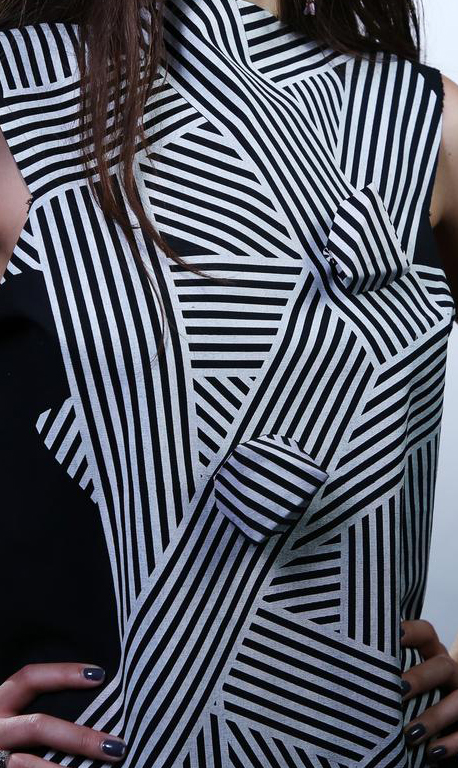
Kino
MIT Media Lab, Stanford University
This work explores a dynamic future where the accessories we wear are no longer static, but are instead mobile, living objects on the body. Engineered with the functionality of 18 robotics, this “living” jewelry roams on unmodified clothing, changing location and reconfiguring appearance according to social context and enabling multitude presentations of self. With the addition of sensor devices, they transition into active devices which can react to environmental conditions. They can also be paired with existing mobile devices to become personalized on-body assistants to help complete tasks. Attached to garments, they generate shape-changing clothing and kinetic pattern designs–creating a new, dynamic fashion.
It is our vision that in the future, these robots will be miniaturized to the extent that they can be seamlessly integrated into existing practices of body ornamentation. With the addition of kinetic capabilities, traditionally static jewelry and accessories will start displaying life-like qualities, learning, shifting, and reconfiguring to the needs and preferences of the wearer, also assisting in fluid presentation of self. We envision a new class of future wearables that possess hybrid qualities of the living and the crafted, creating a new on-body ecology for human-wearable symbiosis.
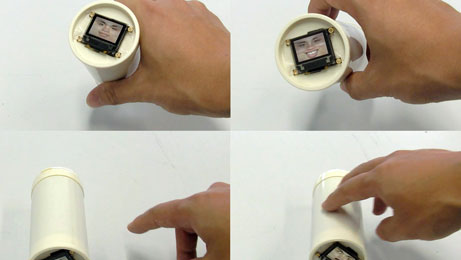
KAZUSHI MUKAIYAMA
IJIROS
file festival
Ijiro is a robot which expresses emotions reacting to a user’s actions. Boldly, it consists of an OLED display, a speaker and an accelerometer in a cylinder shell. Ijiro isn’t able to move itself because it doesn’t have any actuators. However, it expresses emotions with faces in the display and voice from the speaker when a user touches it, lying, standing, swinging, hanging and so on. For example, if a user swings it softly, it reacts smiling. But if a user swings it roughly, it reacts angrily. So those reactions let users feel it like a baby. It is actually baby’s emotions characterized by cognitive science. Also, Ijiro’s shape is designed as a cylinder. It is considered to get various user’s actions because only a cylinder can be stood, lied down, rolled and so on in primitive shapes. Recently it has been easier to use electronic parts for arts. One advantage of making art pieces with compact electronics like a cell phone. So the art style is able to change from being viewed in a large room to being anywhere. Ijiro was developed to entertain people to keep it like a physical pet. We hope you all enjoy touching it.

Hiroshi Matoba
Sun and Moon Room
Sun and Moon Room in the Art Museum of Nature and Human Non-Homogeneity, located in Bungotakada City, Oita, houses one of the interactive art installations designed to extend one’s physicality in contact with the nature. The concept of this work is a room where visitors can play with sunlight. As visitors walk through the room, small apertures on the ceiling automatically open and close, following their movements. The aperture system is designed to envelop the visitors’ bodies in light and to change the shape of the light cast at their feet, mimicking the waxing and waning of the moon. Visitors’ movements are detected by sensors, which trigger to open only the apertures located in the direction of the sun. The room is controlled to create an interior condition that represents the weather of the moment using a program for analyzing live data released by the Japan Meteorological Agency.

Neri Oxman
MAN-NAHĀTA
Computational growth across material and urban scales offers a framework for design through self-organization, enabling the generation of vast, diverse forms exhibiting characteristics like those that emerge through the biological growth processes found in Nature. In this project, we construct an oriented volume spanned by surface normals of the shape at every point. The value of the oriented volume drives the iterative deformation of the shape. Depending on the parameterization of this process, we can obtain distinctly different growing forms. Importantly, the emergence of these forms is driven only by the time evolution of a geometric operator acting on the shapes iteratively, thereby connecting geometry and growth through an algorithm. To form the Man-Nahata landscape, the buildings of the urban landscape are transformed through repeated morphological closing operations, where the field of influence follows a gradient from the center to the outskirts of a circular region.

Juri Hwang
Somatic Echo
“Somatic Echo” is an experimental sound art and research project that utilizes bone conducted sound as a method to investigate human audition and create an unusual and mesmerizing aesthetic of the body as a medium of sound. The installation uses a reclining chair and a sound mask to play an 8-channel sound composition through 8 transducers placed on the user’s head: 6 channels in the face and 2 in the back of the head. The transducers transmit sound through the bone structure of the skull directly to the listener’s inner ear, bypassing the outer ears, which normally are the gateway for auditory signals. The listeners experience the soundscape through both their auditory and tactile senses perceiving a sonic image shaped by the sound traveling through the head structure and through vibrations applied to the skin. This set up lets us experience sound through our body and our body through sound.
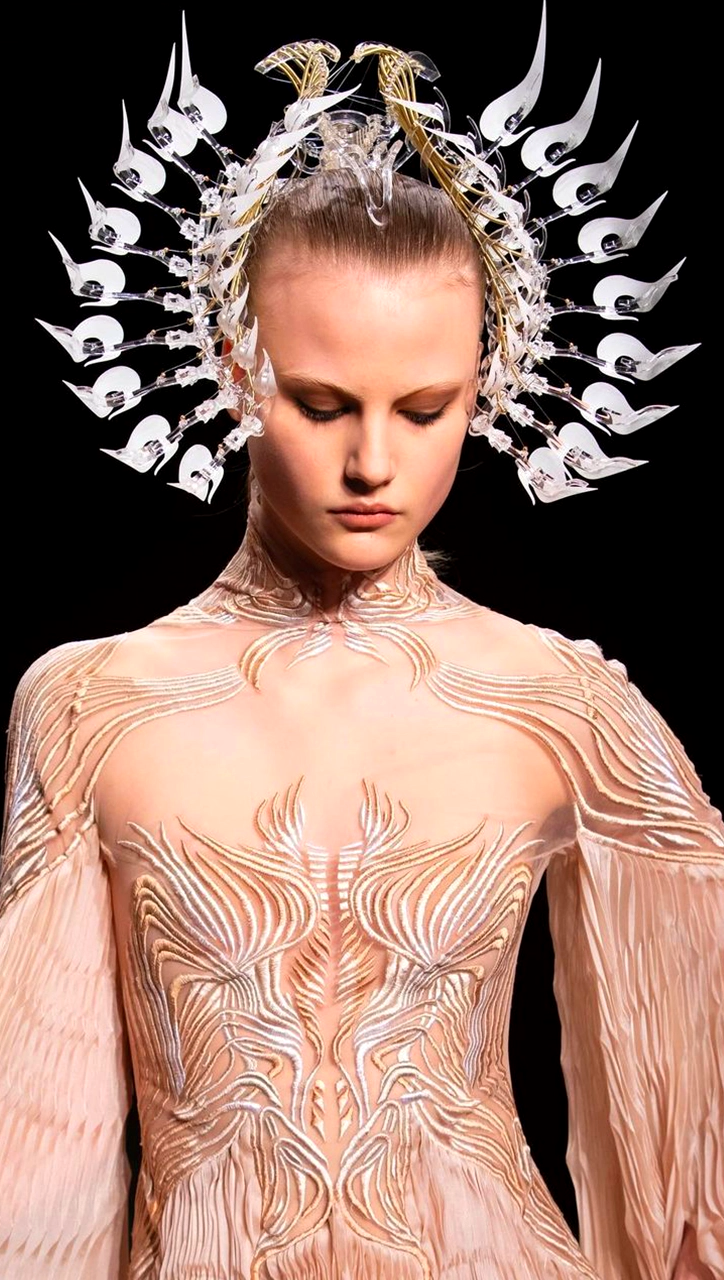
Casey Curran & Iris Van Herpen
Kinetic Sculptures
The ‘Minds in Motion’ crown is made in collaboration with artist @casey_curran. Eighteen transparent monofilament threads meander through a series of brass coils, engineered to continuously shape-shift its silhouette.

Sean Follmer, Mac Schwager & Allison Okamura
An untethered isoperimetric soft robot
The simplest version of this squishy robot is an inflated tube that runs through three small machines that pinch it into a triangle shape. One machine holds the two ends of the tube together; the other two drive along the tube, changing the overall shape of the robot by moving its corners. The researchers call it an “isoperimetric robot” because, although the shape changes dramatically, the total length of the edges – and the amount of air inside – remains the same.

SpY
ORB
The shape of the piece alludes to the ‘pi’ number concealed in the geometry of the Pyramids, found when dividing the perimeter of a Pyramid by twice its height. The sphere is an invisible part of the resulting geometry, since a sphere with a radius as high as the Pyramid would have a circumference very close in length to the Pyramid’s perimeter. The surface of the artwork captures the Pyramids, the sky, the surroundings and the viewers in a multiple fragmented reflection. It references the role of the circular mirror in historical Egyptian symbolism, where it was linked to the sun and conveyed notions of creation and rebirth.

Iris van Herpen & Dutch National Ballet
Biomimicry
For the ‘Biomimicry’ film, Iris van Herpen and Dutch National Ballet explore the symbiotic relationship between the metamorphic force in which fashion and dance interlace. The film, directed by Ryan McDaniels, sees the mesmeric dancer JingJing Mao undulating into liquescent shapes and transcending into graceful figures that reflect her myriad of movements. The concept of the creation stems from the notion of biomimicry — the design and production of materials and systems that are modelled on biological processes. In line with Iris van Herpen’s continuous pursuit to materialise the invisible forces that structure the world, the film focusses on the bond between humanity and nature.

Synichi Yamamoto, Seiichi Sega & Intercity-Express
Noesis
This project was made by inspiration from law of nature and cosmology such as, “View from Inner Earth” ”Wrapped up in Nothing” “Re-mix the Border” “Constructal Law” “Emerging Moments” “Universal Architecture”, and “Superstring Theory”.Science and art have been getting closer in media art scene. Visualization of data and visualization of wave shapes has been actively pursued.

TOSHIO IWAI
Piano
Iwai’s Piano — As Image Media (1995), a later sound work, is related to these early interactive experiments. Here the user, seated at the piano, triggers a flow of images that depress the piano’s keys; a consequence of this action releases yet another flight of images. The resulting interactive installation synthesizes two different aesthetics: sounds (simple melodies), images and a mechanical object (the piano) with digital media. A projected score and computer-generated imagery transform the piano into image media, hence the work’s name. Sound is the triumphant component in these works, for it activates and shapes the visual work. But the visual aspect of Iwai’s installations is lovely. His interactive systems appeal to the creative impulses of adults and children alike with their celebration of animation, computer potential, and the joy of sound.07
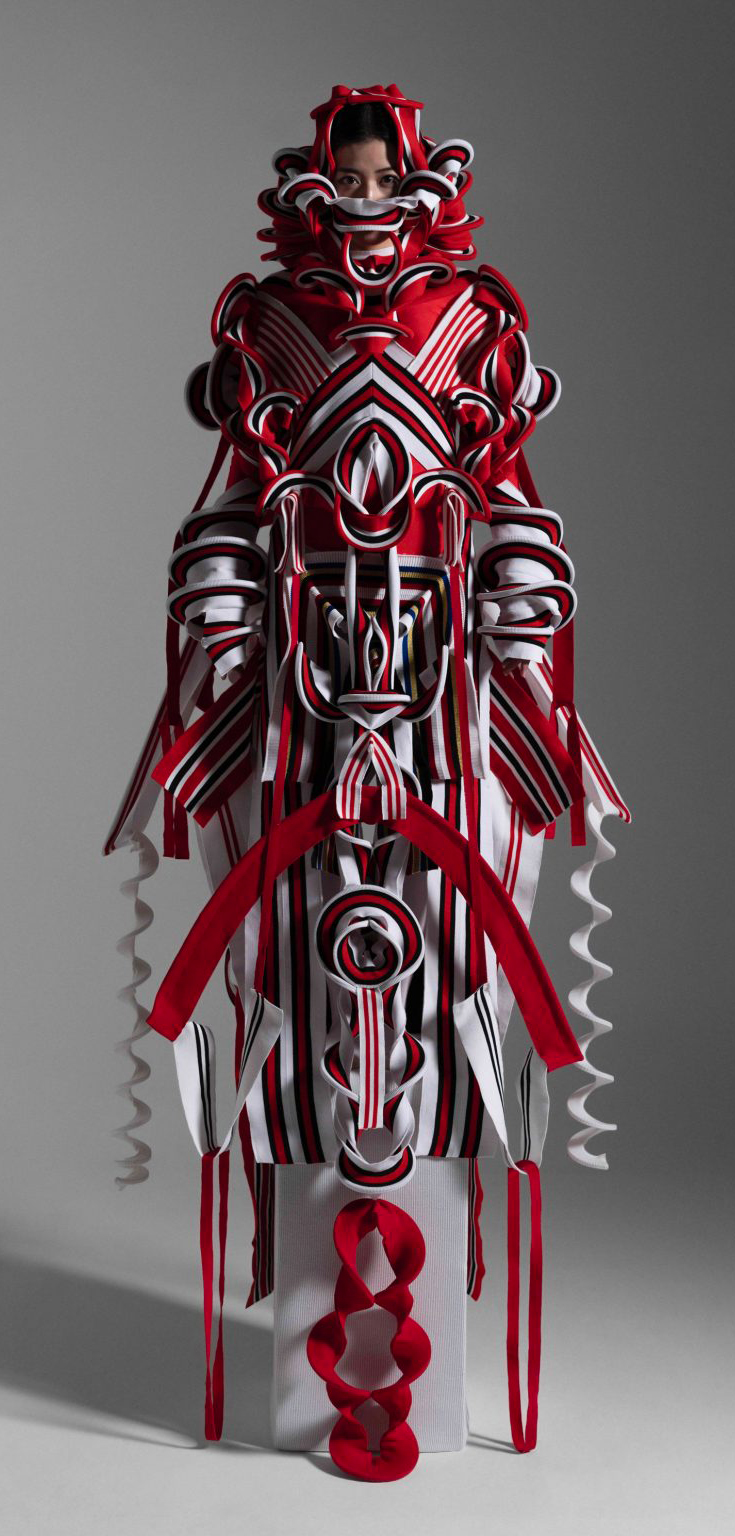
RYUNOSUKE OKAZAKI
Ryunosuke Okazaki 001
For his graduate project from the Tokyo University of the Arts, Ryunosuke Okazaki created a collection consisting of three couture dresses in bold colours and shapes titled JomonJomon that are informed by Japanese Jōmon-era pottery and Shinto, an ancient religion that originated in Japan. The striking designs are modelled and decorated on Jōmon-era pottery, where vessels were decorated through pressing rope and coils into wet clay to create ornate designs. The JomonJomon collection was made using polyester, cotton and ribbed knits, in red, blue, black and white as the primary colours.

Engineered Arts
AMECA
“Multiply the power of artificial Intelligence with an artificial body. Ameca is the physical presence that brings your code to life. The most advanced lifelike humanoid you can use to develop and show off your greatest machine learning interactions. This robot is the digital interface to the real world.” Engineered Arts
.
“A U.K. robotics firm called Engineered Arts just debuted the first videos of its new humanoid robot, which is able to make hyper-realistic facial expressions. It’s a pretty stunning achievement in the world of robotics; it just also happens to be absolutely terrifying.
Named Ameca, the robot’s face features eyes, cheeks, a mouth, and forehead that contort and change shape to show off emotions ranging from awe to surprise to happiness. One of the new videos of Ameca shows it waking up and seemingly coming to grips with its own existence for the first time ever.” Neel V.Patel

Thom Browne
Mens SS 2020
“After the scene shifted from a selection of 2D garments, removed to reveal Browne’s brilliant designs below, the show began in earnest. The looks, as gleefully playful as ever, took on elements of Browne’s typical offerings and elevated them to the level of supreme costume design. Several imposing silhouettes recalled dresses worn by Antoinette-era aristocracy, with gargantuan trousers and shapely sportcoats crafted to resemble distorted Ivy League staples. Elsewhere, pleated skirts emerged as a prime trouser replacement, with cropped jackets and seersucker jockstraps to introduce a sporty motif.” Jake Silbert

Andrea Ling
The Wild Swans
The project is the creation of a series of kinetic garments that tell the story of “The Wild Swans” by Hans Christian Anderson. In the fairy tale, 11 princes have been turned into swans from a transformative spell cast by their wicked stepmother. Their sister, the princess, rescues the princes by collecting stinging nettles and knitting them, under a vow of silence and in great pain, into magical shirts so that her brothers can return to their human shape. She is very nearly done knitting them all when she runs out of time; she throws the sweaters onto her brothers to transform them, but the last one is incomplete, leaving her youngest brother forever with a swan’s wing instead of an arm.
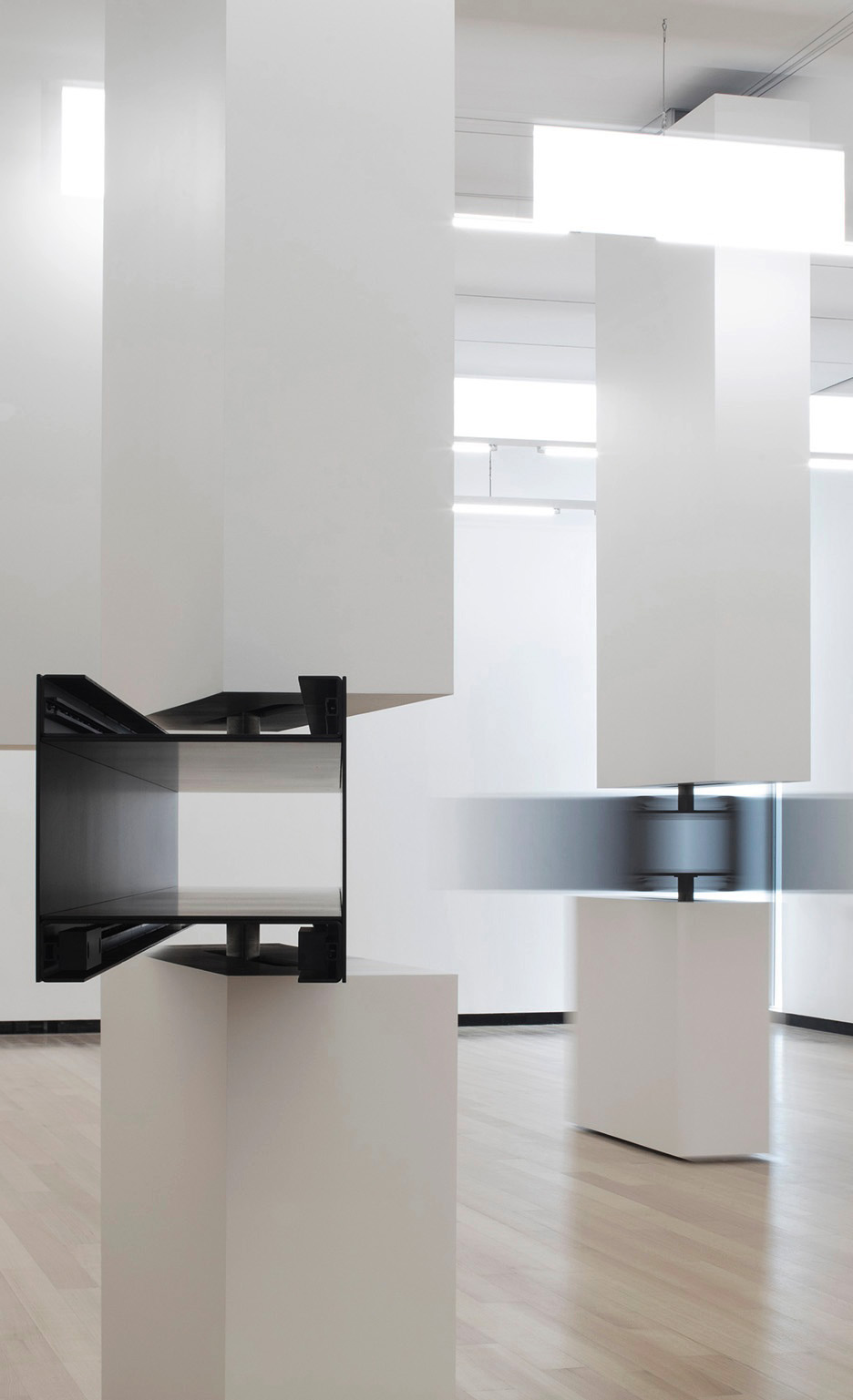
Sarah Oppenheimer
SM-4N
Sarah Oppenheimer’s work explores how individual and collective action can shape the spaces we inhabit. A master of architectural manipulations, her work is interactive, psychological, performative, and at its heart, deeply social.

Penique Productions
Park Lage
In the installation, an 11m x 15m x 25m orange inflatable that completely covered the historic courtyard, the viewer accesses the interior of the work and observes how the previously known space, or not, was reconfigured by a monochromatic plastic cover, through which only the shapes of a reality that has just become a work are drawn. This work makes visible a space that was previously just the place where things live. A work that the wind, the sun, the rain and the passing of people keeps alive, breathing.

Whyixd
#define Moon_
[#define Moon_ ] consists of 9 rotating kinect light installations. It presents different postures of moon shape, exerting new sense experiences. The audience is allowed to explore through various ways of looking and bring curiosity to the installation by watching from different angles. By thinking of the science spirit, once again, viewer can define and understand the concept of this work of their own.

Baumgartner + Uriu Architecture
Supermassive Black Holes
Supermassive Black Holes is an acoustic ceiling installation for the main lobby of the Los Angeles Chamber of Commerce. The design is part of a series of projects in which we work with small primitives that are aggregated into a larger whole. In this case, there are over 10,000 felt cones stitched together into three gigantic, 20’ tall, hanging felt vortexes that that absorb sound through its materiality and geometry. The thousands of cone shape parts trap and disperse sound waves while softening the overall acoustic quality of the space.

Marco Barotti
The Egg
Ten thousand years ago, there were 1 million people living on the planet, fifty years ago there were 3 billion of us and, by the end of this century, we are estimated to reach a population of 10 billion people! We have modified almost every part of our planet and, as we continue to grow, our need for vital resources increases exponentially. We human beings are the main force behind every global problem we face. The work is a kinetic sound sculpture resembling an egg. The cycle of life, reflected in the shape of the sculpture with neither beginning nor end, symbolizes fertility and reproduction – and thus questions the impact of overpopulation. Driven by real-time data generated by the Worldometer, the sculpture constantly changes its shape.

Arcangelo Sassolino
The way we were
Not only does Arcangelo Sassolino transform failure into art, but he manages to make the art of failing a profound part of the art of living. He goes even further in the awareness of risk. He is aware that his experiments may not hold up to the forces that he himself puts in place but this possible collateral damage wants to represent an additional value, becoming precisely the existential metaphor of the concepts of risk and failure. His installations explore the behavior and mechanical limits of matter, he forces their characteristics to distort their shape, gravity, pressure, friction, statics, and of each possibility Sassolino contemplates the risks of collapse with its precise timing and programming.

Andreas Schmelas
Linie II
One second of white rope is traveling through time and space. The white rope is moving at a constant pace along the contours of an imaginary shape, traversing the whole space in several directions and angles. For following that second in the vast space, it requires the viewer to look up while moving his whole head. While passing through long distances as a straight line, it appears to be slow and content. Other passages require quick shifts of direction and the perception changes to fast and sudden movements.

Emilio Vavarella
The Other Shapes of Me
The Other Shapes of Me is het resultaat van mijn onderzoek naar de oorsprong en huidige toepassingen van binaire technologie: van weefsel tot programmering, algoritmen, software, automatiseringsprocessen tot de volledige automatisering van een mens. Bevat de installatievideo rs548049170_1_69869_TT (The Other Shapes of Me); de film Genesis (De andere vormen van mij); de middelgrote wandtapijtenreeks Sections (The Other Forms of Me); de wandtapijtenreeks Samples op klein formaat (The Other Forms of Me); en het kunstenaarsboek rs548049170_1_69869_TT, uitgegeven door Mousse.

Doug Aitken
Sonic Mountain
As a unique site-specific commission for the Donum Estate, Los Angeles-based artist Doug Aitken has created the ethereal work Sonic Mountain (Sonoma), three concentric circles of suspended stainless-steel pipes whose differing lengths form a wave at their base, mirroring the free Euler-Bernoulli shape that describes the chime’s frequency. Installed in the eucalyptus grove, measuring forty-five feet in diameter and twice human height, and comprising 365 chimes — one for each day of the year — Sonic Mountain (Sonoma) works with one of Donum’s most persistent elements, the Carneros breeze that cools the grapes and creates a temperate zone for growing Pinot Noir. Each day, the warm wind begins its soft whisper, rustling through the vines and trees, building in strength through the day until mid-afternoon, and then gradually diminishing in force. Known to have been used since at least the ancient Roman period in Europe and the second century in India and China, wind chimes create chance, inharmonic music. At Donum, Aitken has teamed up with his friend the composer Terry Riley to compose chords in the chimes to be played by the wind , depending on how it blows, so the lyrical work sounds throughout the estate, demonstrating the artist’s practice of making installations that synthesize many media and are never constrained by tradition.
video

STUDIO INI
Urban imprint
“If there is to be a “new urbanism… it will no longer be concerned with the arrangement of more or less permanent … but for the creation of enabling fields….that refuse to be crystallized into definitive form; it will no longer be about meticulous definitions, the imposition of limits, but about expanding notions, denying boundaries, not about separating and identifying entities, but about discovering hybrids; it will no longer be obsessed with the city but with the manipulation of infrastructure for endless intensifications and diversifications, shortcuts and redistributions – the reinvention of psychological space.”, Dutch architect + Harvard Professor, Koolhaas 959, writer of Delirious New York. URBAN IMPRINT is how we design a piece of this new urbanism, an augmented materiality , as we define it. An environment that is a ‘blank canvas’ to be reshaped by the future self.

Emilio Vavarella
The Other Shapes of Me
The Other Shapes of Me es el resultado de mi investigación sobre el origen y las aplicaciones actuales de la tecnología binaria: desde el tejido hasta la programación, algoritmos, software, procesos de automatización, hasta la completa informatización de un ser humano. Incluye la video instalación rs548049170_1_69869_TT (The Other Shapes of Me); la película Génesis (Las otras formas de mí); la serie de tapices de tamaño mediano Secciones (Las otras formas de mí); la serie de tapices Samples de tamaño pequeño (Las otras formas de mí); y el libro de artista rs548049170_1_69869_TT, publicado por Mousse.

Pei Ying Lin
Fractal Microorganisms
The skeletons also has the feature of fractals, which often being mentioned when discussing the forms of nature. Both of symmetry and fractals can be generated from one simple structure. Therefore, I decided to write a script that let people draw a random structure, and using the structure to generate a symmetry fractal shape. The fractals have their diameter through the time according to a sinusoid, making them almost like breathing.

Cornelius Cardew
TREATISE
KYMATIC ensemble
Treatise is a graphic musical score comprising 193 pages of lines, symbols, and various geometric or abstract shapes that largely eschew conventional musical notation. Implicit in the title is a reference to the philosophy of Ludwig Wittgenstein, which was of particular inspiration to Cardew in composing the work.

ROBERT HENKE
光
光正在使用高精度激光在屏幕上绘制连续的抽象形状,并与声音完美同步。强烈的光线与完全的黑暗形成对比,缓慢的动作和微小细节的演化与强而有力的手势一样重要。结果既是古朴的又是未来主义的。新兴的模式为许多可能的解释留出了空间。象形文字,一种未知语言的符号,建筑图纸,数据点之间的连接或类似Tron的早期视频游戏放大了1000倍。
.
Light
Light is using high-precision lasers to draw continuous abstract shapes on the screen, perfectly synchronized with the sound. Intense light contrasts with total darkness, and slow movements and the evolution of small details are as important as strong gestures. The result is both quaint and futuristic. Emerging models leave room for many possible explanations. Hieroglyphs, symbols in an unknown language, architectural drawings, connections between data points, or early video games like Tron are magnified 1,000 times.
.
Lumière
La lumière utilise des lasers de haute précision pour dessiner des formes abstraites continues sur l’écran, parfaitement synchronisées avec le son. La lumière forte contraste avec l’obscurité totale, le ralenti et l’évolution des petits détails sont aussi importants que les gestes forts. Le résultat est à la fois pittoresque et futuriste. Les modèles émergents laissent place à de nombreuses explications possibles. Les hiéroglyphes, les symboles dans une langue inconnue, les dessins d’architecture, les connexions entre les points de données ou les premiers jeux vidéo comme Tron sont agrandis 1 000 fois.

Robert Henke
Destructive observation field
The installation behaves like a living organism, it creates expanding and contracting forms that have a semi-organic appearance. During the course of the exhibition the deformations of the plate add up resulting in a more and more complex surface structure. The visible shapes will get more detailed and fragmented. The density of the stored information on the black plate increases. The characteristic visual appearance of the installation is the result of interference patterns, waves amplifying and canceling each other out in space, leaving complex traces of light and darkness.

marnix de nijs
PIVOT POINT – ICHIHARA
‘Pivot Point – Ichihara’ is an interactive site-specific installation. Standing on a controller pod you navigate over and through a 3D terrain where gravity seems to have disappeared, you gradually become tele-present in a parallel projected space by exploring a mediated version of the venue, it’s direct surroundings and the Ichihara region. A cinematic journey to a fascinating point cloud realm, precise in details but simultaneously abstract and dreamlike.The kidney shaped interface is covered with capacitive sensors and mounted on a pole, touching this interface right, left, up or down aims the virtual camera accordingly. When you release the navigation pole the virtual camera automatically starts spiralling back to the initial starting point your journey and temporary centre of the universe, the Asohbara Art House.
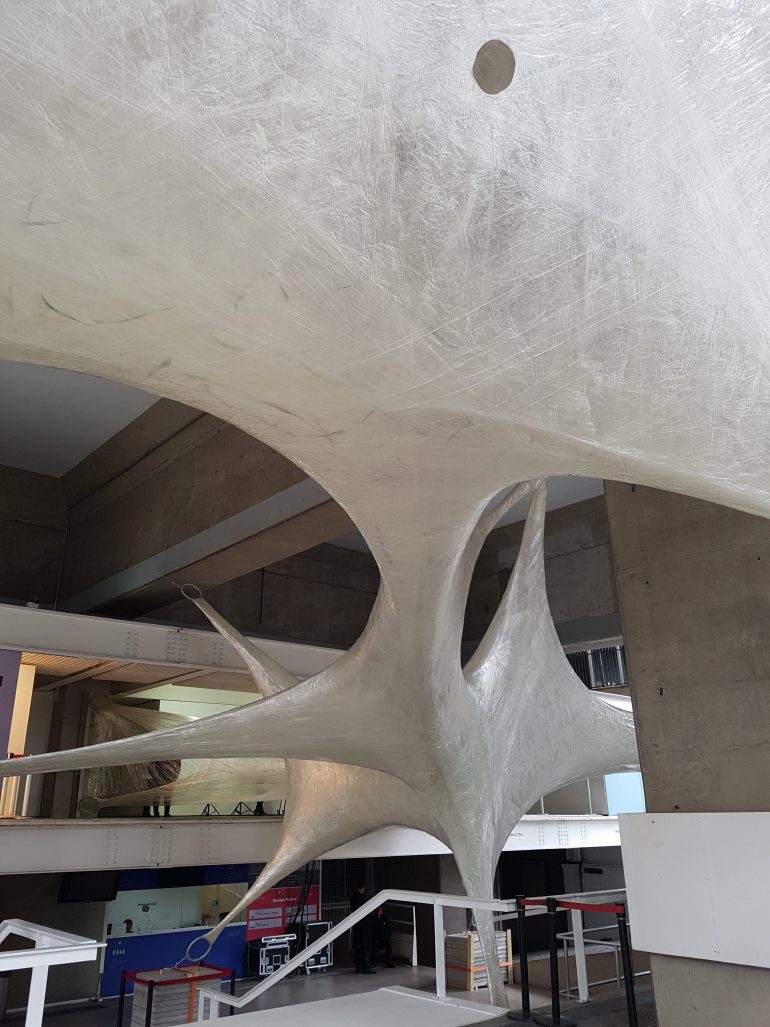
numen / for use
tape sao paulo
file sao paulo 2016
Constant wrapping of pillars with a transparent adhesive tape results in a complex, amorphous surface through the process reminiscent of growing of organic forms. One line evolves into surface that forms an organic shape of extraordinary strength. The entrance of the audience inside the volume transforms the sculpture into architecture. It was practically “found” through the act of chaotic wrapping, where a one-dimensional line (“tape”) slowly turned into two-dimensional plane, which then finally curved into volume.

Robert Breer
Float
The Floats – or floating sculptures – that Robert Breer took up producing again at the end of the 1990s, emerged in 1965. The word “float” meaning something floating – a marker, fishing float or buoy – and which also describes those carnival vehicles whose pretend wheels give them the appearance of floating above the tarmac, enabled Robert Breer to apply this principle to works of a new genre. Primary shapes, neutral colours and, for the most recent, an industrial aspect, the Floats were then made with polystyrene, foam, painted plywood, and, more latterly, out of fibreglass. At first glance, these simple structures appear immobile. In fact, they are moving, imperceptibly, within the space they inhabit. Motorised and on mini-rollers – which raise them slightly above ground, giving them an air of weightlessness – they glide unbeknown to the visitor, following random paths that are interrupted by the slightest obstacle that they encounter.
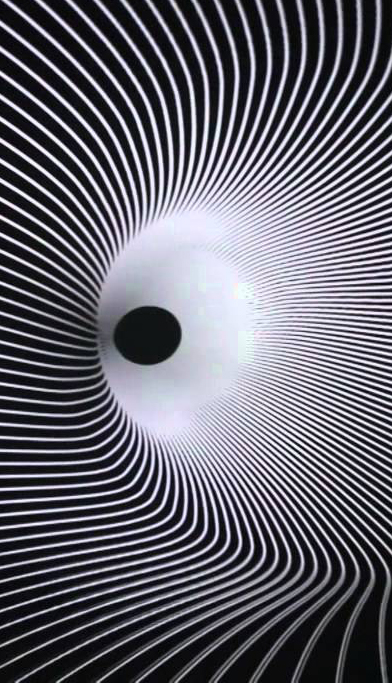
MAOTIK AND FRACTION
Dromos
Dromos is a metaphoric AV Performance that takes its concept from the philosophical work of P. Virilo who is mostly known for founding the idea of Dromology (science of speed). Dromos invites audience to a criticism experience of the ’peed’ role that impacts all aspects of our daily lives. During 40mns, it focuses people attention on this essential factor that shapes our world. With its message, Dromos invites you to wonder about your relationship with progress. It’s an unconventional work with an original sensorial approach, placing the audience inside an immersive environment.
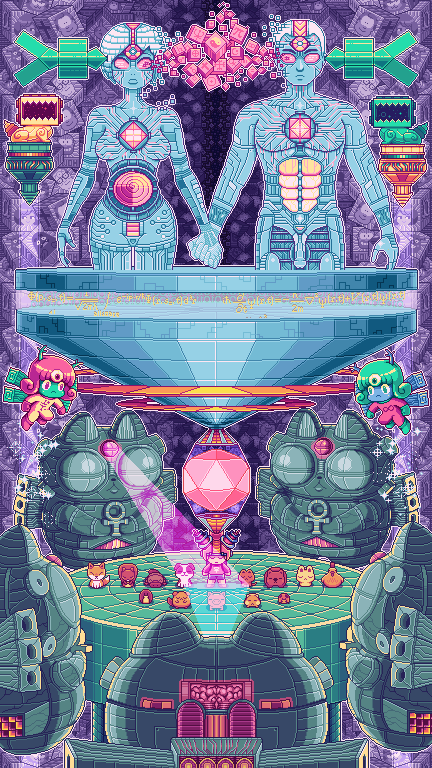
PAUL ROBERTSON
File Festival
Paul Robertson is an Australian animator and digital artist who is known for his pixel art used in short films and video games. He is mostly known for Scott Pilgrim Vs. the World: The Game and the recent release, Mercenary Kings. Apart from his seasoned career as a game designer and movie creator, Robertson has been recently spotted on Tumblr with these GIFS. His interest in inserting flashing neon colors, geometric shapes, Japanese character animation, and 1990′s computer imagery, deems his work as heavily influenced by the Seapunk/Vaporwave aesthetic.

Peter Jansen
The Olympics
Peter Jansen (1956) studied Physics and Philosophy at the university.For a number of years he worked as a guide, accompanying groups on survival and canoe trips, after which he dedicated his live entirely to the arts. Based on his ideas on transposition and movement the artist Peter Jansen uses shapes of the human body to create energetic spaces.
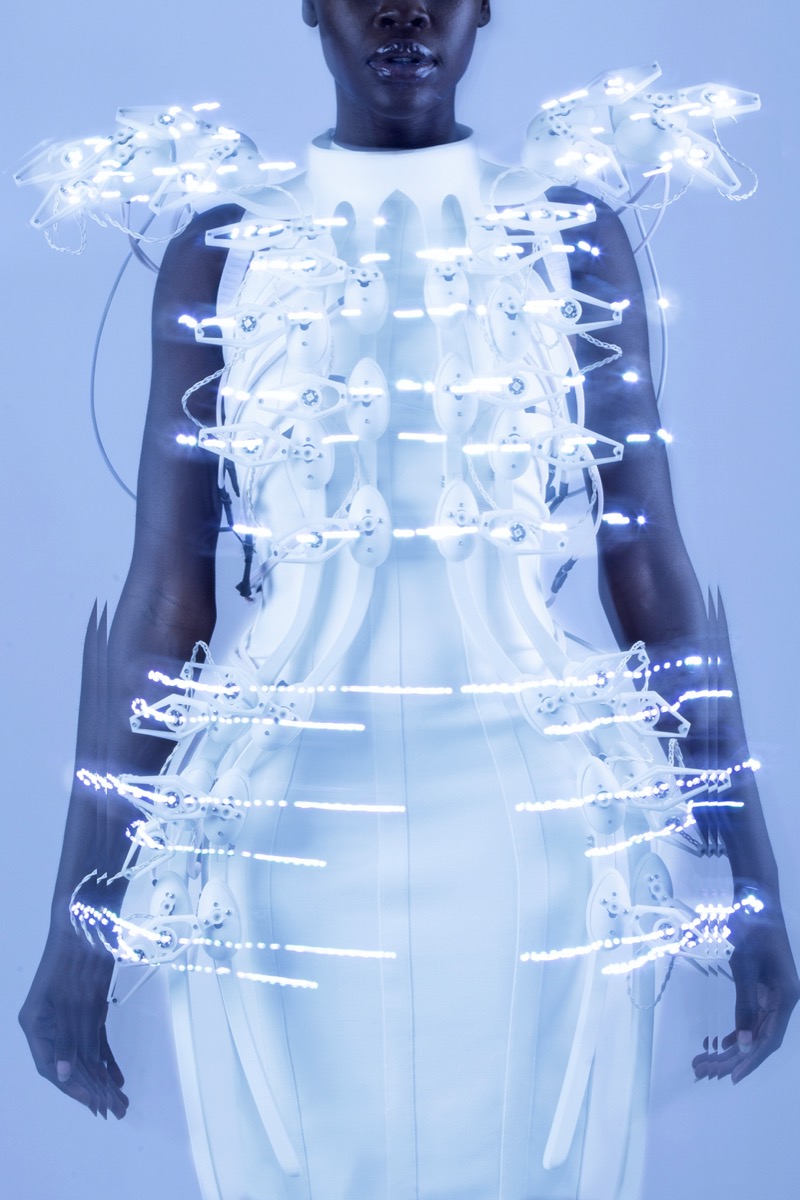
ANOUK WIPPRECHT
PANGOLIN DRESS
The Pangolin Scales Project demonstrates a 1.024 channel BCI (Brain-Computer Interface) that is able to extract information from the human brain with an unprecedented resolution. The extracted information is used to control the Pangolin Scale Dress interactively into 64 outputs.The dress is also inspired by the pangolin, cute, harmless animals sometimes known as scaly anteaters. They have large, protective keratin scales covering their skin (they are the only known mammals with this feature) and live in hollow trees or burrows.As such, Pangolins and considered an endangered species and some have theorized that the recent coronavirus may have emerged from the consumption of pangolin meat.Wipprecht’s main challenge in the project’s development was to not overload the dress with additional weight. She teamed up 3D printing experts Shapeways and Igor Knezevic in order to create an ‘exo-skeleton’ like dress-frame (3mm) that was light enough to be worn but sturdy enough to hold all the mechanics in place

